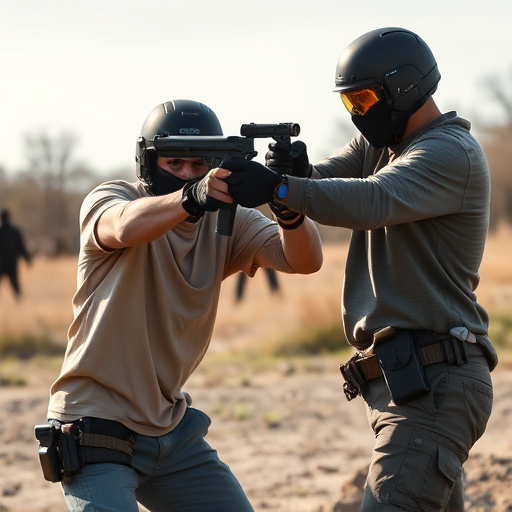Defensive spray (pepper spray) is a popular self-defense tool with varying legality globally. Its effectiveness stems from capsaicin, the active ingredient. Choosing the "strongest" legal pepper spray involves considering not just concentration but also delivery system and individual sensitivity. Modern advancements in spray technology enhance its efficacy. Selection should balance strength, ingredients (measured in Capsaicin Units – CU), range, pattern, reliability, brand reputation, and local regulations to ensure legality and maximum impact in self-defense scenarios. Proper training in activation techniques, application, handling, storage, and de-escalation is crucial for effective civilian protection and legitimizing its usage.
“In today’s diverse and sometimes unpredictable world, civilians are increasingly turning to defensive spray as a crucial tool for personal protection. This comprehensive guide delves into the intricacies of understanding and utilizing legal pepper spray ingredients effective for self-defense. We explore the ‘strongest’ ingredients, their effects, and efficacy, while also highlighting key factors in choosing the right spray. Additionally, we discuss proper use and training to ensure safety, legitimacy, and maximum protection.”
- Understanding Defensive Spray: Legal Considerations and Citizen Rights
- Deconstructing the 'Strongest' Pepper Spray Ingredients: Effects and Efficacy
- Choosing the Right Spray: Factors to Consider for Personal Protection
- Effective Use and Training: Maximizing Safety and Legitimacy in Self-Defense
Understanding Defensive Spray: Legal Considerations and Citizen Rights
Defensive spray, also known as pepper spray or oleoresin capsicum (OC) spray, is a non-lethal self-defense tool designed to incapacitate an attacker temporarily. When used legally and responsibly, it can provide civilians with a crucial layer of protection in potentially dangerous situations. However, understanding the legal considerations surrounding its use is essential for citizens considering carrying defensive spray.
The legality of pepper spray varies by jurisdiction, with some regions allowing its possession for self-defense while others restrict or prohibit it. In many places, law enforcement agencies and civilians must adhere to strict guidelines regarding the type, capacity, and accessibility of spray devices. The strongest legal pepper spray ingredients are often those that contain high concentrations of capsaicin, the active compound responsible for the burning sensation associated with chili peppers. These ingredients ensure maximum effectiveness while still being subject to regulatory oversight to prevent misuse.
Deconstructing the 'Strongest' Pepper Spray Ingredients: Effects and Efficacy
When it comes to defensive spray, understanding the “strongest” ingredients isn’t as straightforward as one might think. Often marketed with bold claims, what truly makes a pepper spray effective relies on more than just a high capicity of active ingredients. The key lies in a combination of factors: concentration, delivery system, and individual sensitivity.
While some advocate for higher concentrations of oleoresin capsicum (OC), the primary ingredient in pepper spray, this doesn’t guarantee superior performance. A balanced formulation, considering occlusion and airflow, can significantly enhance efficacy. Additionally, modern advancements in spray technology, like improved nozzles and fine mist distribution, ensure better contact with the target area, maximizing irritant exposure. Remember, the “strongest” legal pepper spray ingredients aren’t just about potency; they’re about effective application designed to disrupt an assailant’s vision, breath, and mobility.
Choosing the Right Spray: Factors to Consider for Personal Protection
When selecting a defensive spray for personal protection, understanding the key factors is essential. One of the primary considerations is the strength and ingredients of the spray. Pepper spray, known for its effectiveness in disabling assailants temporarily, comes in various potencies measured in capsaicin units (CU). The strongest legal pepper spray ingredients typically offer higher CU ratings, ensuring maximum impact when needed.
Other factors to weigh include range and spray pattern, as well as the spray’s overall reliability and ease of use. It’s crucial to choose a brand that is reputable and has a proven track record for quality and effectiveness. Additionally, considering legal implications and local regulations regarding self-defense sprays is vital to ensure their legality and maximize personal protection in various scenarios.
Effective Use and Training: Maximizing Safety and Legitimacy in Self-Defense
Effective use and training are paramount when considering defensive spray for civilian protection. Beyond simply acquiring the device, proper education and practice can significantly enhance safety and legitimize its usage. Users must understand not only how to activate the spray but also the optimal distance and angle for application, ensuring it reaches the intended target while minimizing risk to bystanders.
Training sessions should cover safe handling practices, including storage and maintenance of the spray, as well as de-escalation techniques. Knowing when to use defensive spray is crucial; individuals should be trained to assess threat levels and only deploy it when necessary for self-defense. Additionally, familiarizing oneself with the strongest legal pepper spray ingredients can provide a better understanding of their effectiveness and help make informed decisions when choosing a suitable defense tool.
When considering defensive spray for civilian protection, it’s crucial to balance effectiveness with legality. Understanding the strongest legal pepper spray ingredients and how to choose the right one is key. Proper training in effective use and recognition of legal considerations are essential for maximizing safety and legitimacy in self-defense scenarios. Remember, while defensive spray can be a valuable tool, it should be used responsibly and in accordance with local laws.
